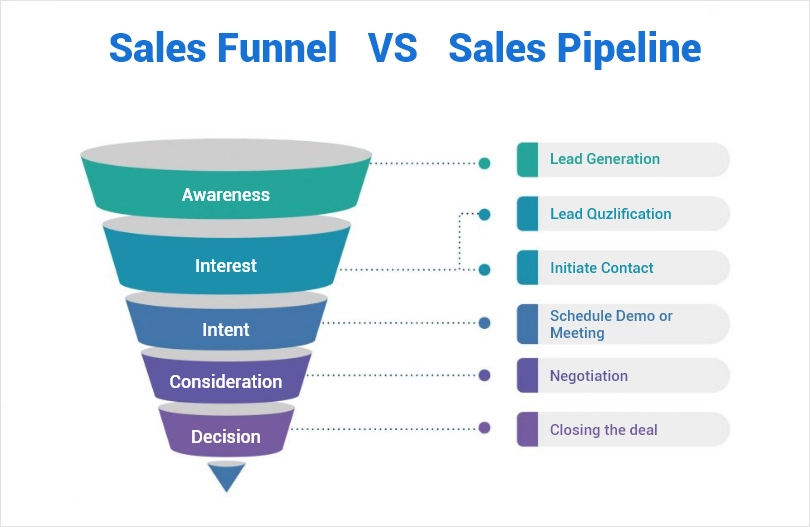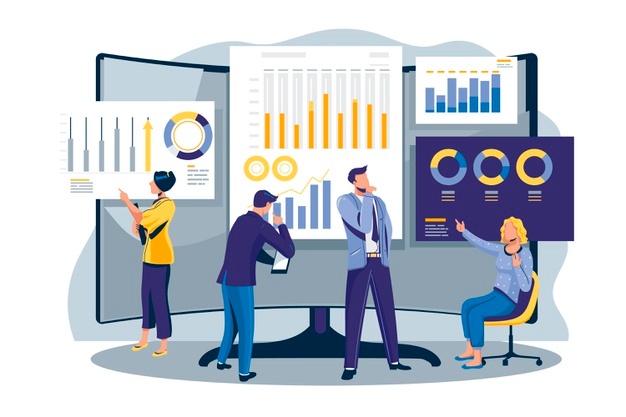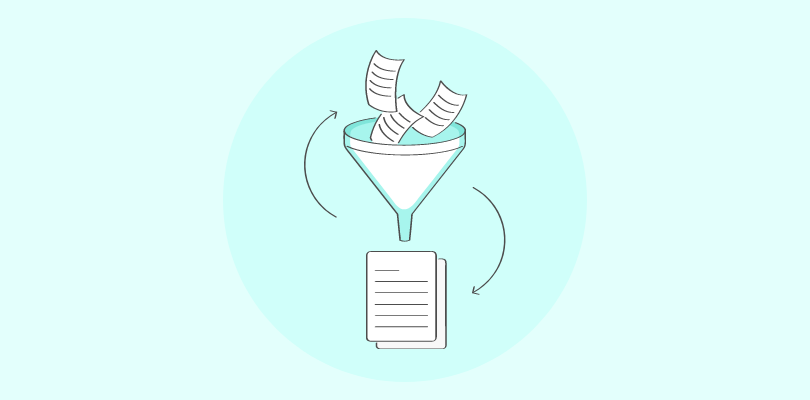How often have you heard sales professionals throwing around the term ‘Sales Pipeline’ when talking about potential opportunities?
We’re guessing quite a few.
On these occasions, it can help to have a clear understanding of what a sales pipeline is and how it can affect your revenue.
This blog covers how to build a sales pipeline to help guide your customers from attraction to action!
A sales pipeline can help you get in better control of your processes. In simple terms, it is an effort to understand your customers and, in turn, target your sales approach to get more profits.
Every prospect for your company should pass through this pipeline. This requires the pipeline to be dynamic and actionable for every department of your company.
This puts forth the question-
Can you develop a custom sales pipeline that fits the specific requirements of your organization?
The answer is a resounding YES!
Refer to this comprehensive guide to learn more about how building and customizing a sales pipeline can benefit your business.
What is a Sales Pipeline?
Your prospects have to move through various stages when they enter the sales cycle. These stages are company-specific and make up the sales pipeline.
A simple answer to what is a sales pipeline is- a reflection of a buyer’s journey through the sales process.
As is evident from the name, a pipeline refers to a set of steps that a buyer will pass through from initial contact to final purchase. It also encompasses all the potential opportunities available to the sales team. It can help you:
- Keep track of the number of acquired leads
- Identify qualified buyers
- Find areas in the sales cycle that can be improved
- Forecast Revenue
Some buyers in your pipeline may be more proactive than others. A sales pipeline can help you keep track of which stage has been completed concerning that particular buyer. You can also use this information to find out the chances of the deal closing.
How is a Sales Pipeline Different From a Sales Funnel or Sales Forecast?
Now that you know what pipeline means in sales, it is essential to address what it doesn’t include. People usually confuse a sales pipeline with a sales funnel or forecast. However, all of these are discrete terms with varying significance in the sales process.
Sales Funnel:
Although sometimes used interchangeably, both sales pipeline and funnel differ significantly.
A sales pipeline implies that most prospects should drop off after the qualification. On the other hand, the sales funnel conveys that the prospects will continue to drop off as the process continues.
A sales funnel involves customers as well as leads that could potentially become your customers.
Image Source: Freshworks
Sales Forecast:
A Sales Forecast, as the name suggests, is the likelihood of opportunities converting into sales within a specified time frame. It is an estimate of the number of deals that the company is likely to close in a given period. The forecast helps businesses find out if they are on the right track to achieve their sales targets.
On the other hand, a pipeline is a visual demonstration of all the opportunities in your sales process.
Is It Beneficial to Have a Sales Pipeline?
“I like to think of sales as the ability to gracefully persuade, not manipulate, a person or persons into a win-win situation.” – Bo Bennett.
A study by Harvard Business Review reveals that a defined sales pipeline can yield an 18% increase in the revenue growth of all organizations. Additionally, companies that have mastered pipeline management can see up to a 28% increase in their revenue.
The more targeted your sales approach is, the more likely you are to form meaningful relationships with the customers. In the absence of a streamlined pipeline, you will end up missing out on sales opportunities because you failed to target them at the right time.
With effective sales pipeline management, your sales reps can identify promising prospects and work with them. Along with being useful in day-to-day operations, it can also play a vital role in the long-term strategic planning associated with sales.
Reduce the Length of the Sales Cycle:
The sales pipeline can provide an estimate of how long it takes for your team to close the sale. Keeping track of the sales cycle length can help you identify which steps are taking the most time and if there is a way to automate some processes to reduce the sale cycle’s duration.
Keep Track of Your Progress:
A popular reason why businesses invest in sales pipeline management software is that it allows them to review their progress and be aware of what comes next. It also provides the opportunity to make any amendments required in the sales process to achieve targets better.
Zero in on Accounts With Potential:
A significant advantage of building a sales pipeline is that it allows you to distinguish between customers based on the likelihood of conversion. You can distribute your time and human resources judiciously and modify your pitch accordingly.
Predict Revenue:
Sales Pipeline can be instrumental in forecasting revenue since it can give an estimate of which leads are likely to convert. You can set realistic sales goals with the help of valuable insights gained from assessing the performance of your current sales pipeline.
Monitor Your Team’s Performance:
With pipeline management software, you can find out how well every sales representative is doing. You can keep track of who amongst your team is the closest to meeting the sales targets and who requires more assistance.
Discover Resource Gaps or Any Other Hindrances:
Building a sales pipeline can help you identify possible resource gaps or any other bottlenecks within the sales process. This can contribute to an increase in overall organizational efficiency, helping you convert more leads to customers.
Stages of a Sales Pipeline
While every company may have a different approach to closing deals, the stages of their sales pipeline remain broadly the same. When learning how to build your sales pipeline, you need to keep in mind the following stages.
Prospecting:
The first stage of a sales pipeline is to let your customers know that your business exists. There are several ways to generate leads, including ad campaigns, quizzes, live chats, surveys, etc.
Leads Qualifying:
After prospecting, you have to identify which leads are the right fit for your organization and are likely to convert. This is a research-intensive process and should be allocated adequate time. It is better to identify quality leads initially to avoid wasting time on consumers unwilling to buy your product.
Initiating Contact:
Once you have identified valuable prospects comes the part of actually getting in touch with them. This can be done through cold calling, emailing, or any other platform.
Meeting:
If the lead is interested in your services, you can schedule a meeting to deliver your pitch. Use this opportunity to emphasize the competitive advantages of your product and how it can address the prospect’s specific requirements.
Negotiation:
This is one step closer to closing the deal. You have to negotiate the prices, terms, etc., to settle on a mutually agreeable arrangement.
Sales Closing:
This is the final stage, where you mark the outcome of the deal as won or lost.
Building Relationship:
There are certain things to address post-purchase. Your team has to monitor the account and keep track of the customers regularly to enable repurchasing or upselling.
Pro-Tip: Investing in a long-term relationship with existing customers can be much more beneficial than you think!
Following up on Prospects Not Won Yet:
One of the stages of a sales pipeline that should not be overlooked is following up on cold leads. Check in with them every now and then to find out if they are willing to make the purchase now.
Once you learn how to build a sales pipeline, you can modify these stages for your convenience. For instance- you can break down a stage into components if that is easier for you to track. But remember not to include too many stages in the sales pipeline as it may become unmanageable.
5 Steps to Build a Custom Sales Pipeline
Now that you have gained an understanding of what the sales pipeline is, you can move on to how to build a sales pipeline that is unique to your business.
1. Identify and Determine Prospective Buyers:
Before you learn how to create a pipeline for sales, take some time to identify who your ideal buyer would be. This will help you find out which stages to include in the sales pipeline. Do adequate research to find out what challenges your target audience faces and how your product can solve these problems.
2. Calculate the Number of Opportunities for Each Stage:
After setting the stages for your pipeline, you need to calculate the numbers you have to work with. Keep in consideration your average win rate, sales cycle length, etc., to find out how many opportunities you need to work with at every stage. Once you have the numbers, begin the process of lead generation using whatever tools you deem suitable.
3. Define the Sale Cycle Metrics:
If you wish to learn how to grow a sales pipeline, you need to set relevant metrics like length, sales targets, etc. This will help your team get a clearer picture of what they are working towards and how close they are to their targets.
4. Find out What Helps Conversions:
Now that you have the stages and the metrics for the sales pipeline in place, you need to find out what propels deals from one stage to the next. The actions that may affect your deal flow should be mastered in order to ensure more sales closing.
5. Create or Modify Your Sales Process Around This Information:
Once you gain a complete understanding of what is pipeline sales and what stages to include, you can build an actionable and scalable routine.
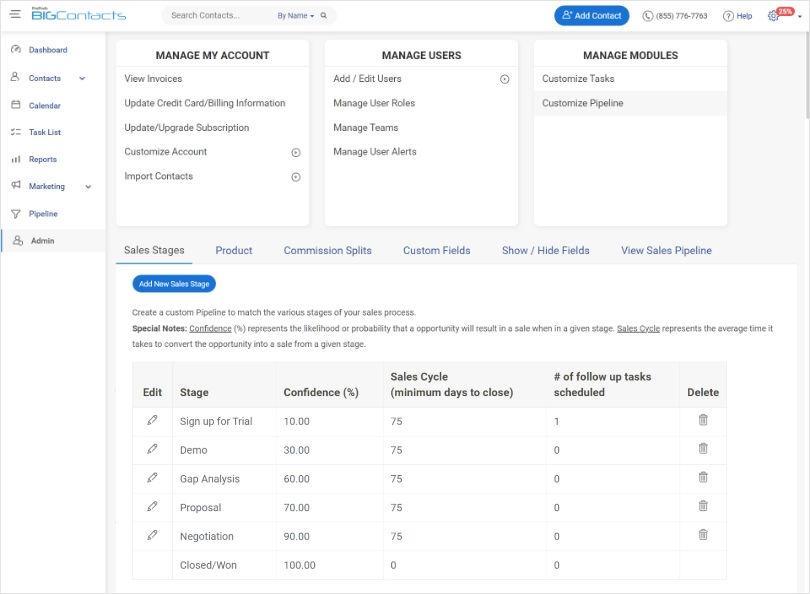
Some Pro-Tips:
- Use an effective CRM tool for sales management.
- Perform regular clean-up of the sales pipeline.
- Pay attention to the sales pipeline velocity and other such factors that depict the pipeline’s health.
Read More: How To Customize Sales Pipeline
7 Important Metrics to Include in a Sales Pipeline
There are several ways to customize your sales pipeline. But how do you find out if it is working well for you?
The answer to this question is setting relevant metrics.
The inclusion of these metrics can make sales pipeline management and review much easier.
1. Source of the Lead:
Identifying the sources of your leads can help you track the performance of your pipeline. Find out which sources generate the highest number of leads that convert into sales. Another relevant metric that you can add to your sales pipeline is the total number of deals you are working on.
2. Deal Size:
Not every deal has the same contract value. You can segment leads based on the amount they are willing to spend and allocate your time and resources accordingly.
3. Win Rate:
Win rate is a measure of leads converted by the end of the sales cycle. Including win rate as a metric in your sales pipeline can help you find out if your efforts are yielding the desired results.
4. Sales Cycle Length:
Keep track of the average length of a sale cycle. This will help you find out if your sales pipeline is functioning healthily.
5. Sales Velocity:
Sales velocity measures the speed at which leads progress through your pipeline and convert into customers. In other words, it is an estimate of how quickly you are making profits. The higher is your sales velocity, the healthier your pipeline is.
6. Deal Fallout:
Monitor the number of deals that fall out at every step of the pipeline. This can help you understand what went wrong and make relevant changes in your pipeline to prevent your numbers from taking a hit.
7. Lead Response Time:
Find out how long it takes for your team to reach out to prospects. If this number spikes, maybe it’s time to hire more people or find out what is lacking in your current pipeline.
How to Effectively Manage a Sales Pipeline?
Now that you understand what a sales pipeline is, comes the next big question-
How do you manage a sales pipeline to yield the best results?
Effective management of the pipeline can help you get a competitive advantage. It allows you to make more informed decisions about budget allocation, setting targets, hiring personnel, etc. You can make your sales approach much more targeted and efficient with the help of a sales pipeline in place.
To better organize, monitor, and manage your sales pipeline after its development, follow these steps:
Keep Track of Relevant Metrics:
Whether it’s the number of opportunities that typically pass through one stage to the next or the average sales velocity, you need to stay on top of things. The metrics you have included in your sales pipeline can help you see the bigger picture and make better decisions for your long-term growth and sustenance.
Ensure the Accuracy of the Data:
A huge mistake that you could make with your sales pipeline is to consider it static. The pipeline is ever-changing and, therefore, needs to be updated frequently. New leads come in, and some leads fall out.
To prevent your pipeline from becoming inefficient, make sure that the data being fed into the pipeline management software is accurate and up to date. Data is the most important factor, and understanding the data pipeline is essential.
Periodically Review the Pipeline:
Make sure that your pipeline is updated and optimized by carrying out periodic reviews. Get rid of any blockages in the pipeline to ensure maximum profits. This also means getting rid of any dead leads that show no interest or have become hard to get in touch with.
Automate Processes:
80% of the sales are made only after the fifth attempt at following up. However, this becomes challenging when dealing with a large number of leads. So, how do you ensure timely follow-up for all your potential customers?
“The answer to this question is simple- Automation.”
Automate emails and tasks to reach out to customers at the right time. This can increase the productivity of your sales pipeline and help you maximize your earning potential. You can automate processes based on triggers like the customer entering a new stage of the pipeline.
Read More: Automated Tasks and Emails for Your Sales Pipeline
Focus on the Sales Cycle Length:
It’s no surprise that the length of the sales cycle can significantly affect your win rate. The more long-drawn-out your sales cycle is, the more likely you are to lose customers. This is why you should keep the sales pipeline short and clean. Choose a CRM tool to help you manage the key aspects of a sales pipeline effectively and see a significant improvement in your profits.
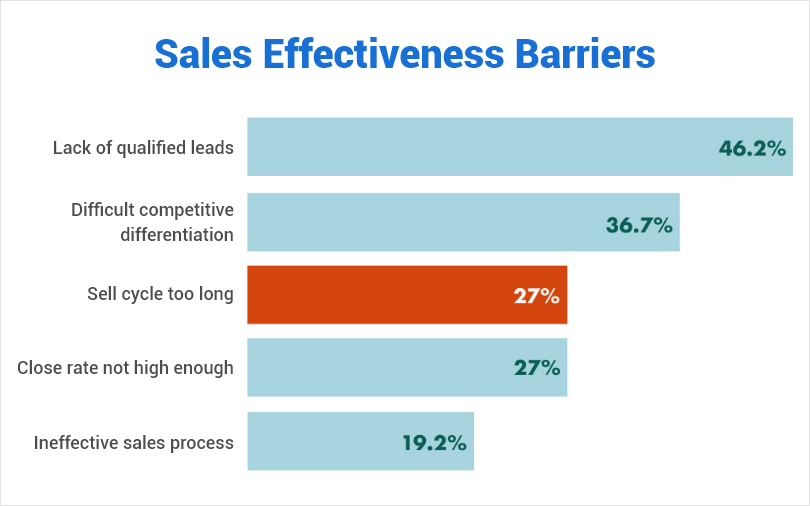
Image Source: Superoffice
Creating and Managing a Sales Pipeline With BIGContacts CRM
To leverage the boundless potential of the sales pipeline, you need to ditch the conventional spreadsheet and switch to something that adds to the visibility and reliability of your sales pipeline.
You can automate the management with the help of a reliable CRM tool. Whether you need to send follow-up emails or schedule meetings, do it conveniently with a CRM.
The more data you have, the better can be your predictions and management of the sales pipeline. Therefore, BIGContacts CRM can be the perfect tool for managing your sales pipeline.
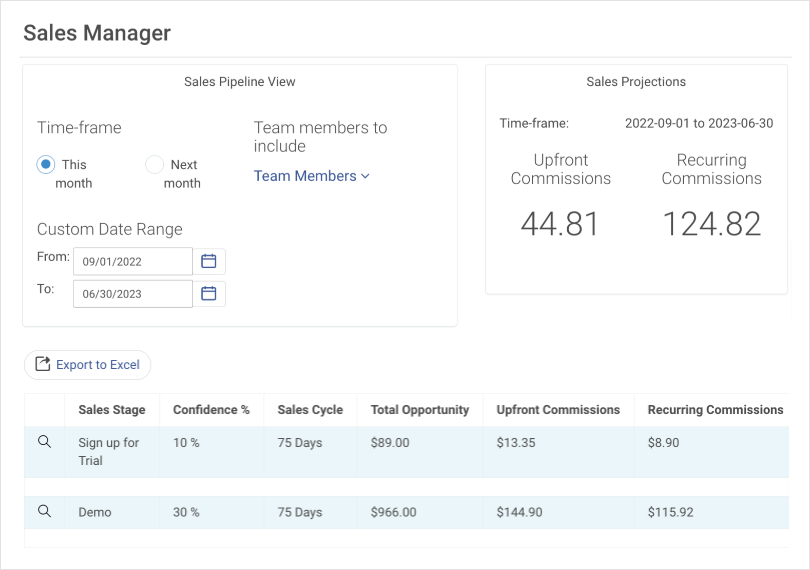
Get rid of manual and tedious tasks that eat up your valuable time with BigContacts!
65% of sales representatives use some form of CRM, and over 61% of these are likely to hit the annual sales target. Impressive, right? There’s more where this comes from!
Capture Leads From Multiple Sources:
A CRM tool can not only help you acquire qualified leads from multiple sources but also offer centralized storage for accessing these leads. You can use BIGContacts to assign leads to team members directly and monitor their progress.
Keep Track of Previous Interactions for Easy Follow-Up:
You can find out when the last touch with the client was and their current status in the sales cycle. The detailed contact profile offered by CRM helps understand users and their buying preferences better.
Reporting and Analytics:
What makes BIGContacts an efficient sales pipeline management software is the custom reports and analytics feature. You can find out if you are likely to achieve your sales target with the help of these reports.
Enhanced Collaboration:
CRM eases collaboration between different departments, making it easier to improve customer relationships and retention rates. This can significantly boost your revenue and offer opportunities for growth.
Automated Emails:
Automation is an important factor to consider when you are learning how to increase sales. With CRM, you can send automated email alerts and schedule meetings to ensure that deals do not fall through the cracks.
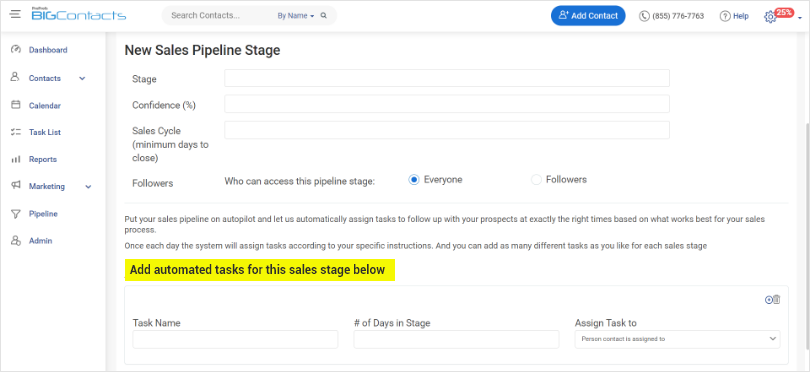
Read More: Sales Pipeline Overview
Build a Custom Sales Pipeline to Never Miss out on Sales Opportunities Again
Are a lot of your leads going cold?
Maybe it’s time to integrate a sales pipeline into your operations.
A standardized sales process can not only aid in lead generation but also help increase customer loyalty for your business. Before learning how to build a sales pipeline, understand your customers and their requirements. This will help you move deals from one stage to the next effectively.
Remember – “Mastering the sales pipeline may not be easy, but it is definitely going to be worth your while.”
FREE. All Features. FOREVER!
Try our Forever FREE account with all premium features!

